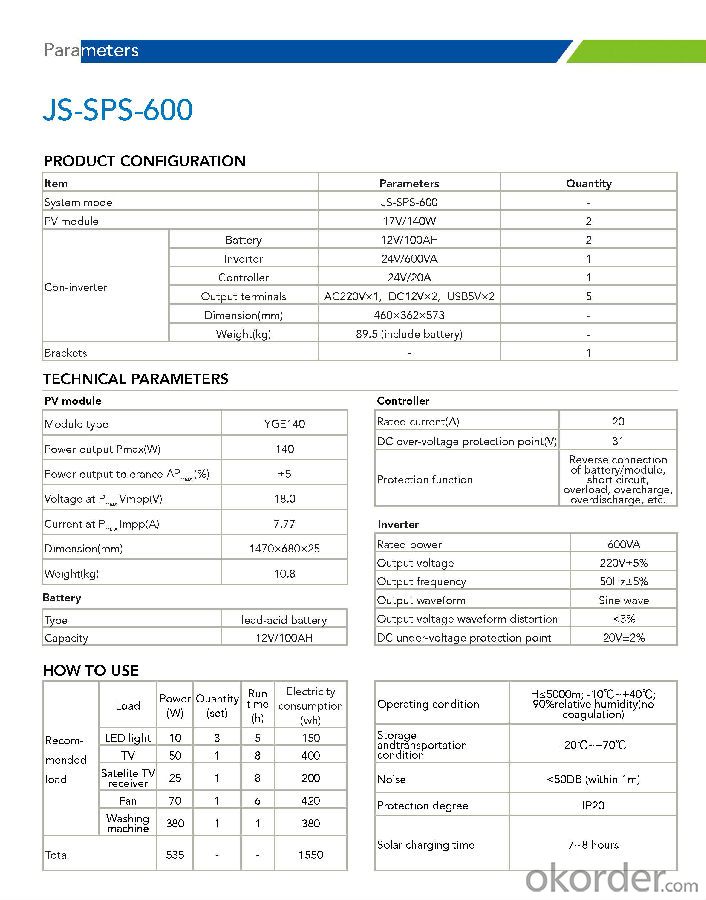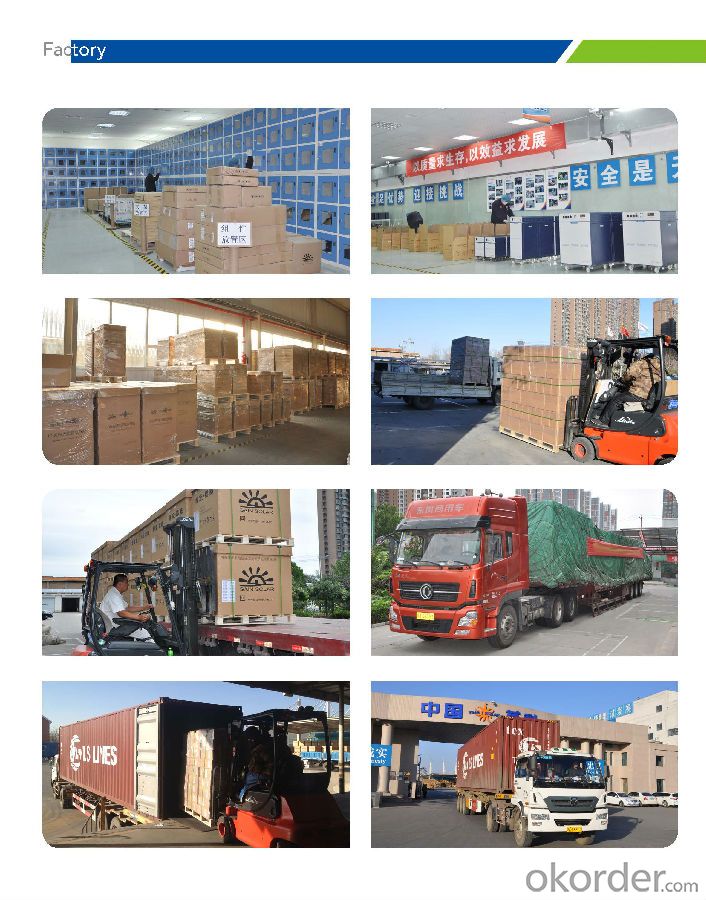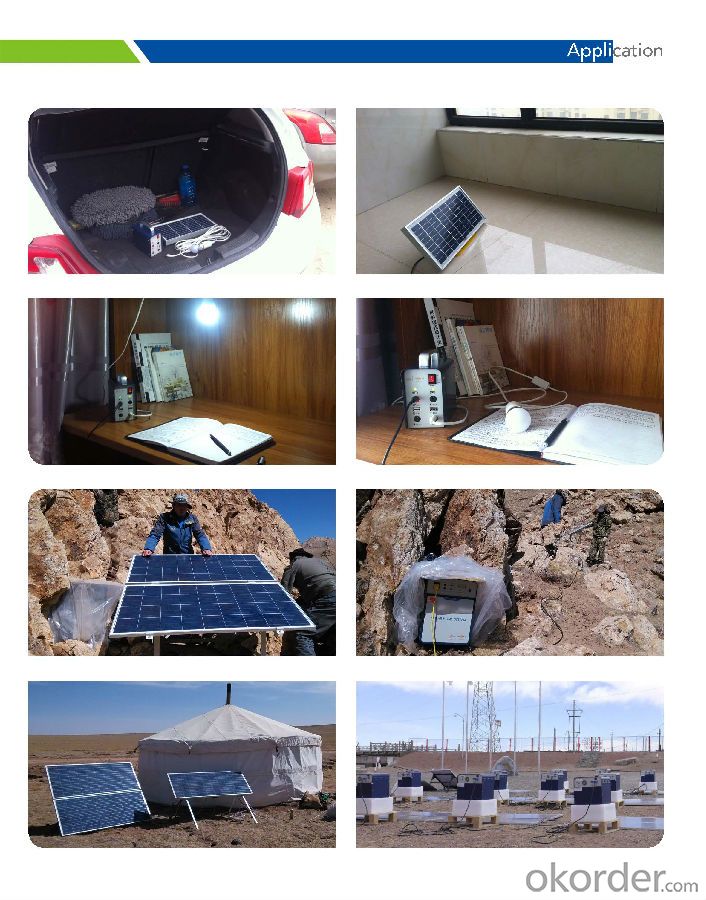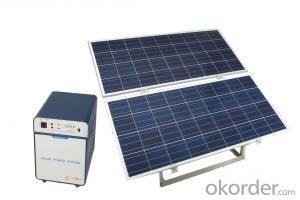Off-grid Solar Power System JS-SPS-600
- Loading Port:
- Tianjin
- Payment Terms:
- TT OR LC
- Min Order Qty:
- 10 set
- Supply Capability:
- 10000 set/month
OKorder Service Pledge
OKorder Financial Service
You Might Also Like
General Introduction
Solar power system provides alternating current and direct current, which is produced by the modules transforming solar power into power, to home lighting, household appliance and other DC appliance, such as cell phone and laptop.
Solar power system is widely used in area lack of power, for example house power supplying, monitoring, communication base, fire prevention in forest area, pasture and meadow, aquaculture etc.
We are dedicated to provide high quality off-grid PV products and systems to customers and has received a series of certificate, including ISO9001, TUV, UL, CE, CQC and RoHS.
Off-grid Solar Power System
High efficent PV module can produce more power.
Sine wave output is suitable for all kinds of load. Varieties of DC output, let it more
convenient for users.
The multifunction design make it easy to operation and maintenance.



- Q:Can solar energy systems be used for emergency backup power?
- Yes, solar energy systems can be used for emergency backup power. Solar panels can generate electricity during daylight hours, which can be stored in batteries for use during power outages or emergencies. This provides a reliable and sustainable source of backup power, reducing dependence on traditional energy sources and ensuring continuous electricity supply during critical situations.
- Q:What is the impact of dust storms on solar panels?
- Solar panels can be significantly affected by dust storms. The build-up of dust and debris on the panel surface can block sunlight, resulting in reduced efficiency and electricity generation. Dust particles act as a barrier, preventing sunlight from converting into electricity, leading to decreased power output and overall performance. Moreover, physical damage can also occur during dust storms. The panel surfaces can be scratched or chipped by abrasive particles carried by strong winds, causing long-term degradation and reduced efficiency. Additionally, the accumulation of dust and debris can raise the panel temperature, further decreasing efficiency. To mitigate the impact of dust storms, regular cleaning and maintenance are crucial. Periodic cleaning removes dust and debris, helping to maintain efficiency and maximize electricity generation. Furthermore, installing tilt systems or self-cleaning technologies can effectively prevent or shed off dust accumulation, minimizing the impact of dust storms. In conclusion, dust storms can negatively affect solar panels, reducing efficiency and potentially causing physical damage. However, proper maintenance and cleaning practices can minimize these effects, allowing solar panels to continue generating clean and sustainable energy.
- Q:How often do solar energy systems need to be cleaned?
- Solar energy systems generally need to be cleaned at least once or twice a year. However, the frequency of cleaning can vary depending on factors such as the local climate, amount of dust or debris accumulation, and location of the solar panels.
- Q:Can solar energy systems be used in areas with limited access to solar batteries?
- Yes, solar energy systems can still be used in areas with limited access to solar batteries. While solar batteries are commonly used to store excess energy generated by solar panels, they are not essential for the operation of solar energy systems. In such areas, solar energy can be directly consumed during daylight hours, providing a sustainable and renewable source of electricity. However, without batteries, the energy supply may be intermittent or limited to daytime usage only.
- Q:Can solar energy systems be used for powering industrial manufacturing plants?
- Yes, solar energy systems can be used for powering industrial manufacturing plants. In fact, many industrial manufacturing plants across the world are already utilizing solar energy systems to reduce their reliance on fossil fuels and decrease their environmental impact. Solar energy systems consist of photovoltaic (PV) panels that convert sunlight into electricity. These panels can be installed on the roofs or open spaces of manufacturing plants to harness the abundant solar energy. The electricity generated by the solar panels can be used to power various processes and equipment within the industrial plant, such as machinery, lighting, heating, ventilation, and air conditioning systems. The use of solar energy for powering industrial manufacturing plants offers numerous benefits. Firstly, solar power is a renewable and clean source of energy, which helps reduce greenhouse gas emissions and dependence on fossil fuels. This aligns with the growing need for sustainable practices and reducing the carbon footprint of industries. Secondly, solar energy systems can significantly reduce electricity costs for manufacturing plants. Once the initial investment is made to install the solar panels, the operational costs are relatively low. Additionally, some countries offer incentives and subsidies for implementing solar energy systems, further reducing the financial burden. Moreover, solar energy systems can provide a stable and reliable source of electricity. With advancements in battery storage technology, excess solar energy can be stored and used during non-sunlight hours or in times of high demand. This helps ensure uninterrupted power supply and reduces the reliance on the grid. However, it is important to note that the feasibility of using solar energy systems for powering industrial manufacturing plants depends on various factors, such as the availability of sunlight, the size of the plant, energy requirements, and the initial investment cost. Additionally, some manufacturing processes may require a consistent and higher level of electricity that may not be fully met by solar energy alone. Overall, solar energy systems have proven to be a viable and sustainable option for powering industrial manufacturing plants. Their use can contribute to reducing carbon emissions, lowering electricity costs, and promoting a greener and more environmentally friendly industrial sector.
- Q:Solar photovoltaic system
- To search and collect profit (in all spontaneous terms): the average recovery of funds on average generating capacity = * (distributed generation electricity subsidies + residential electricity price =200* (0.42+0.55) =194 were the first year of the recovery of funds = daily recovery funds *365=194*365=70810 yuan investment recovery period = total investment / average recovery of funds is about =450000/70810=7.06 years. 6.5 years 25 years average annual net income = recovery funds * (20 -6.5) + daily average generation price *365 * electricity days *5 years =70810*13.5+200*0.55*365*5=1156680 yuan
- Q:What is the payback period for a solar energy system?
- The payback period for a solar energy system refers to the time it takes to recover the initial investment through energy savings. It typically varies depending on factors such as the cost of the system, government incentives, energy consumption, and local electricity rates. On average, the payback period for a residential solar energy system ranges from 5 to 10 years, while commercial systems may have shorter payback periods due to higher energy consumption.
- Q:Can solar energy systems be used for powering electric vehicle wireless charging systems?
- Yes, solar energy systems can indeed be used for powering electric vehicle wireless charging systems. The energy generated from solar panels can be converted into electricity and stored in batteries. This stored energy can then be utilized to power wireless charging stations for electric vehicles, providing a sustainable and renewable source of power for their charging needs.
- Q:Can solar energy systems be used in commercial buildings?
- Yes, solar energy systems can be used in commercial buildings. In fact, many businesses and organizations are increasingly adopting solar power to meet their energy needs. Solar panels can be installed on rooftops, parking lots, or other suitable areas of commercial buildings to generate clean and renewable energy. This helps reduce electricity costs, decrease carbon footprint, and promote sustainability in the commercial sector.
- Q:What is a solar inverter and what does it do?
- A solar inverter is an essential component of a solar power system that converts the direct current (DC) electricity produced by solar panels into alternating current (AC) electricity, which is used to power our homes and businesses. It is responsible for optimizing the energy output from solar panels and synchronizing it with the electrical grid.
1. Manufacturer Overview |
|
|---|---|
| Location | |
| Year Established | |
| Annual Output Value | |
| Main Markets | |
| Company Certifications | |
2. Manufacturer Certificates |
|
|---|---|
| a) Certification Name | |
| Range | |
| Reference | |
| Validity Period | |
3. Manufacturer Capability |
|
|---|---|
| a)Trade Capacity | |
| Nearest Port | |
| Export Percentage | |
| No.of Employees in Trade Department | |
| Language Spoken: | |
| b)Factory Information | |
| Factory Size: | |
| No. of Production Lines | |
| Contract Manufacturing | |
| Product Price Range | |
Send your message to us
Off-grid Solar Power System JS-SPS-600
- Loading Port:
- Tianjin
- Payment Terms:
- TT OR LC
- Min Order Qty:
- 10 set
- Supply Capability:
- 10000 set/month
OKorder Service Pledge
OKorder Financial Service
Similar products
New products
Hot products
Hot Searches
Related keywords





























